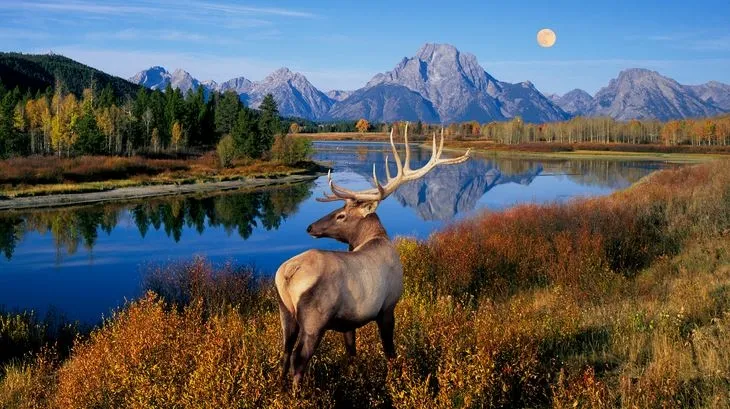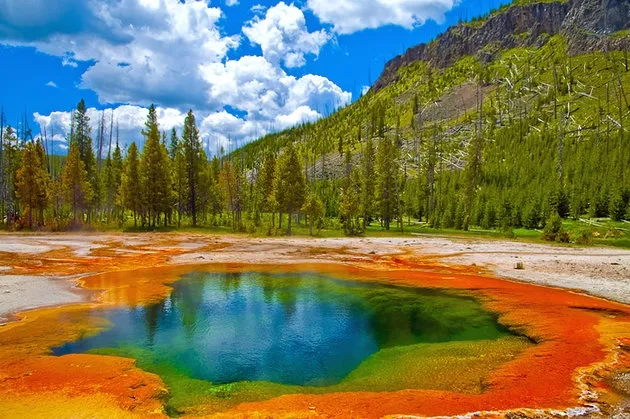Wyoming, a mountain state in the western United States, is renowned for its pristine and majestic natural beauty. It’s not only a dream destination for adventure travelers but also a paradise for those passionate about exploring the wildlife world. With admirable conservation efforts, Wyoming proudly boasts numerous top-notch wildlife conservation areas, where visitors can witness rare animals in their natural habitats. Join “Du lịch khắp thế gian” to explore the most amazing wildlife conservation areas in Wyoming, where nature and wildlife blend together to create a vivid and enchanting picture.
Grand Teton National Park – Home to Diverse Wildlife
Grand Teton National Park, located in northwestern Wyoming, is one of the jewels of the U.S. National Park System. It’s not only famous for its majestic mountain scenery and crystal-clear lakes but also a vital wildlife sanctuary. Grand Teton maintains an ideal natural habitat for countless animal species, from familiar ones to rare species that you may hardly find anywhere else.

Grand Teton is home to over 60 different mammal species, including grizzly bears, black bears, moose, elk, wolves, bobcats, foxes, otters, and many other small animals. In particular, the park is one of the most important areas in the United States for grizzly bear conservation. Visitors to Grand Teton have the chance to admire large grizzly bears foraging in meadows or spot herds of elk leisurely grazing by the lake shore.
Besides mammals, Grand Teton is also a haven for bird species. More than 300 bird species have been recorded in the park, from majestic bald eagles soaring in the sky, and peregrine falcons fiercely hunting on cliffs, to small colorful birds like sparrows, woodpeckers, and hummingbirds. Bird lovers can spend hours observing and recording the wonderful moments of the bird world at Grand Teton.
To experience the wildlife world at Grand Teton, visitors can participate in various activities. Hiking is a great way to explore the park and increase your chances of encountering wildlife. Trails like Cascade Canyon Trail, Jenny Lake Trail, or Taggart Lake Trail are all popular choices. Visitors can also join boat tours on Jenny Lake or Jackson Lake to admire the scenery and observe animals from a different perspective. Cycling is also an enjoyable activity, allowing you to explore the park slowly and closely with nature.
Travel tips for wildlife exploration at Grand Teton:
- Best time to visit: Summer (from June to August) is the ideal time to visit Grand Teton and observe wildlife. The weather is warm and pleasant, and animals are more active.
- Observation locations: Meadows, lake shores, and riverbanks are often where many wild animals congregate. Dawn and dusk are the times when animals are most active.
- Maintain a safe distance: Always keep a safe distance from wildlife and do not feed them. Use binoculars or cameras with telephoto lenses to observe from afar.
- Join guided programs: The park offers many guided programs about wildlife, helping you better understand the ecosystem and how to conserve animals.
Yellowstone National Park – Land of Geothermal Wonders and Wildlife
Spanning across three states—Wyoming, Montana, and Idaho—Yellowstone National Park is the first national park in the United States and also one of the largest and most diverse wildlife conservation areas in the world. Yellowstone is not only famous for its unique geothermal wonders like Old Faithful geyser and Grand Prismatic Spring but also a paradise for wildlife.

Yellowstone is home to nearly 67 mammal species, almost 300 bird species, 16 fish species, and 5 amphibian and reptile species. Large mammal species include grizzly bears, black bears, gray wolves, mountain lions, moose, elk, bison, and Bighorn sheep. Yellowstone is one of the few places in North America that still maintains a wild gray wolf population. Visitors may be lucky enough to witness wolf packs hunting in the Hayden or Lamar valleys.
Besides mammals, Yellowstone is also an ideal destination for bird lovers. The park is a habitat and migration route for many rare bird species such as bald eagles, peregrine falcons, ospreys, whooping cranes, and many other waterfowl. Yellowstone Lake and wetland areas are gathering places for many waterfowl in spring and autumn.
Exploring Yellowstone to witness wildlife is an unforgettable experience. Visitors can drive along scenic routes like Lamar Valley Road and Hayden Valley Road, where many wild animals congregate. Hiking is also a great way to explore the park and increase your chances of encountering animals. Trails like Fairy Falls Trail, Mystic Falls Trail, or Uncle Tom’s Trail offer beautiful natural scenery and wildlife viewing opportunities.

Travel tips for wildlife exploration at Yellowstone:
- Best time to visit: Similar to Grand Teton, summer (from June to August) is the best time to visit Yellowstone and observe wildlife. However, the park can be very crowded in summer, so you may consider visiting in spring or autumn to avoid crowds.
- Observation locations: Lamar Valley and Hayden Valley are the two most famous areas for wildlife viewing in Yellowstone. In addition, the areas around Yellowstone Lake and sparse forest areas are also home to many animals.
- Bring binoculars: Binoculars are indispensable when wildlife watching. They help you observe animals from a distance without disturbing them.
- Be patient and quiet: Wildlife observation requires patience and quietness. Take your time to wait and stay silent to increase your chances of encountering animals.
National Elk Refuge – Admire Majestic Elk
The National Elk Refuge, located right next to the town of Jackson, Wyoming, is an important area for the conservation of North American elk. In winter, thousands of elk from the surrounding mountains migrate to the refuge to find food and shelter. This is an incredibly impressive natural spectacle and attracts many visitors to admire.
The National Elk Refuge was established in 1912 to protect the largest elk herd in the world. In winter, the number of elk at the refuge can reach tens of thousands. Visitors can join horse-drawn sleigh tours to explore the refuge and admire the magnificent elk herds up close. In addition to elk, the refuge is also home to many other wildlife species such as bison, foxes, wolves, and bald eagles.
Travel tips for exploring the National Elk Refuge:
- Best time to visit: Winter (from December to March) is the ideal time to visit the National Elk Refuge and admire the elk migration.
- Join a sleigh tour: Sleigh tours are the best way to explore the refuge and view elk safely and comfortably.
- Visitor center: The refuge’s visitor center provides useful information about the history, ecosystem, and wildlife of the refuge.
Seedskadee National Wildlife Refuge – Waterfowl Paradise
Seedskadee National Wildlife Refuge is located in southwestern Wyoming, along the Green River. This refuge is known as a paradise for waterfowl and migratory birds. With a diverse ecosystem including rivers, wetlands, grasslands, and shrub forests, Seedskadee provides an ideal habitat for hundreds of different bird species.
Seedskadee is an important stopover on the migration route for many waterfowl species such as mallards, Canada geese, trumpeter swans, and whooping cranes. In spring and autumn, thousands of waterfowl congregate at the refuge to rest and feed before continuing their migration journey. In addition to waterfowl, Seedskadee is also home to many other bird species such as bald eagles, peregrine falcons, ospreys, woodpeckers, and sparrows.
To explore Seedskadee, visitors can hike on trails, kayak on the Green River, or camp at designated campsites. Birdwatching is the most popular activity at Seedskadee, and the refuge has many birdwatching spots equipped with telescopes and information boards.
Travel tips for exploring Seedskadee National Wildlife Refuge:
- Best time to visit: Spring and autumn are the best times to visit Seedskadee and observe migratory birds.
- Bring binoculars and bird guides: Binoculars and bird guides will help you identify and observe bird species more easily.
- Participate in birding events: The refuge regularly hosts birding events, such as guided bird walks and bird identification classes.
Conclusion
Wyoming is not only a beautiful state with majestic natural landscapes but also a great destination for wildlife enthusiasts. The wildlife conservation areas in Wyoming offer rare opportunities to witness rare animals in their natural habitats. From the magnificent elk herds at the National Elk Refuge, to the wildlife diversity at Grand Teton and Yellowstone National Parks, and the abundance of bird species at Seedskadee National Wildlife Refuge, Wyoming is sure to please any traveler passionate about exploring the wild natural world. Plan your trip to Wyoming and experience unforgettable moments in these wonderful wildlife conservation areas!